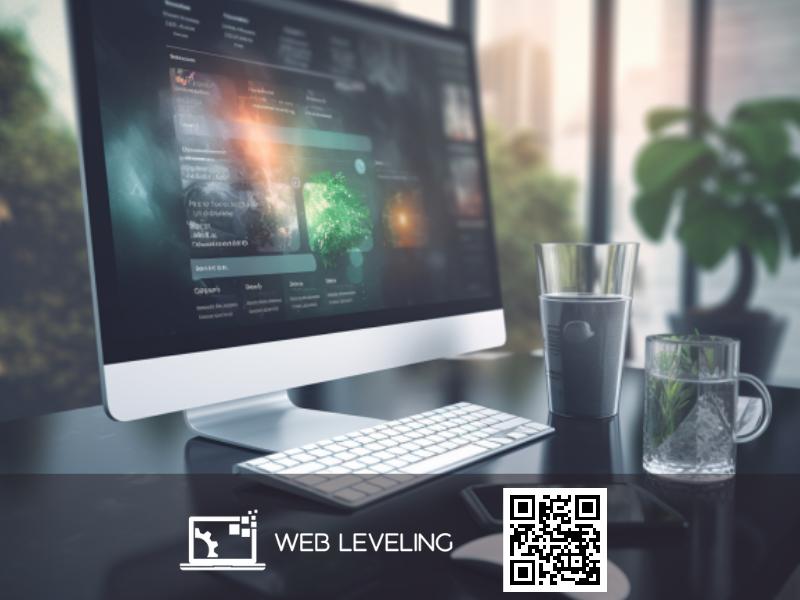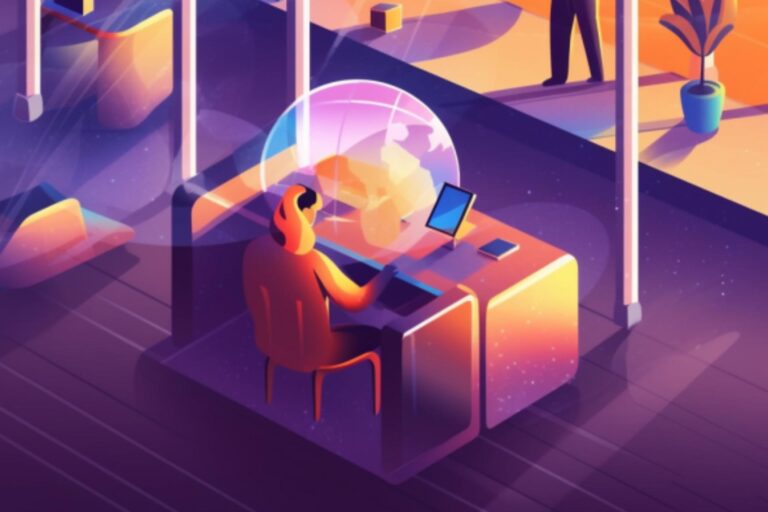10 Essential Web Design Trends You Can’t Ignore In 2023
The world of web design is constantly evolving, and if you don’t keep up with the latest trends, it’s easy to get left behind.
It can feel like a daunting task keeping up with all the changes in technology, but this article will make it easier by focusing on 10 essential web design trends that can’t be ignored in 2023.
By understanding these key elements now, you’ll be able to stay ahead of the curve and create an impactful website for years to come.
1. Dark Mode Dominance: Enhancing User Experience And Reducing Eye Strain
Dark mode has been around for some time, but it’s rapidly becoming one of the most popular web design trends. As more and more users opt for dark themes on their devices, websites are beginning to follow suit in order to provide a better user experience.
Dark mode makes text easier to read by providing a higher contrast between text and background colors, reducing eye strain during extended viewing times. It also offers unique aesthetic benefits that can be used to create beautiful designs with bold visuals and vibrant color palettes.
From settings menus to entire website themes, dark modes have become increasingly common across different platforms. This has led many developers and designers alike to prioritize this feature when creating new projects or revamping existing ones.
Additionally, dark mode is now an integral part of accessibility workflows as it allows visually impaired people to access content without being overwhelmed by strong contrasts or bright backgrounds.
The growth of dark mode will only continue into 2023, making it essential for any developer or designer looking to stay ahead of the curve. By actively seeking out ways to incorporate dark theme options into your project, you’ll ensure that all users receive an optimal experience regardless of their device preferences.

2. Glassmorphism: The Evolution Of Frosted Glass Aesthetics In Ui Design
Glassmorphism is like a foggy window, providing users with an opaque yet inviting view of the digital world. It brings together light and shadows to create depth and intrigue in user interfaces that can be used for both mobile and desktop applications.
The soft, blurred edges of glassmorphism evoke feelings of mystery and add character to any design. This trend has evolved from frosted glass aesthetics, which have been popular since the early days of UI design.
Here are some characteristics of this unique style:
- Organic Shapes: Glassmorphism uses curvy shapes instead of straight lines or sharp angles, giving it a more organic look.
- Light & Shadow Effects: By utilizing shadows, highlights, and gradients, designers can create subtle transitions between elements on the page, creating a sense of depth and dimensionality.
- Blurred Edges: Blurred edges help soften up the overall appearance by making objects appear as if they’re fading away into the background. This gives designs an ethereal quality that makes them stand out from other styles.
The result is an aesthetic that focuses on interactive elements without overwhelming users with too many details or colors. Its simple yet sophisticated look adds warmth and personality to web pages while still maintaining its modern appeal.
As 2023 draws closer, expect glassmorphism to become even more prominent in UI design.

3. Mobile-First Design: Prioritizing Seamless User Experience On Smaller Screens
The mobile-first approach to web design is becoming increasingly popular as more and more people are accessing the internet exclusively on their phones. Designers need to prioritize a seamless user experience for users of smaller screens. This means making sure that all content is accessible and easy to read while also utilizing responsive design techniques like grid layouts and media queries.
Designing with mobile in mind should be an integral part of any website development process. It’s no longer enough to have a desktop version of your site. UI/UX designers must create intuitive navigation and page structures that work across different devices without compromising quality or functionality.
Additionally, they should optimize images for small screens, utilize larger buttons for easier tapping, and use device-specific features such as GPS location tracking when appropriate.
Overall, designing with mobile first in mind can help ensure that your website works well both on smartphones and other devices, providing a consistent user experience regardless of what platform someone is using. With this approach, you can make sure your visitors get the best possible experience each time they visit your website.

4. Inclusive Design: Crafting Websites Accessible To Everyone
Inclusivity should always be a cornerstone of any website design. This means ensuring that all users can access the content, regardless of their physical or mental abilities.
Websites that use inclusive design principles will provide features such as high-contrast visuals and adjustable text size to make sure everyone is able to enjoy the experience. Additionally, these sites often include audio alternatives for those with visual impairments, along with support for assistive technologies like screen readers.
It’s also important to keep accessibility in mind when developing multimedia items on your site. For example, if you have videos or animations that rely heavily on sound effects or voice-overs, then captioning them will help ensure they’re accessible to hearing-impaired visitors. Similarly, adding subtitles and transcripts to podcasts can allow people who are deaf or hard of hearing to follow along with the conversation.
Designers must also consider how intuitive it is for users to interact with their websites’ navigation menus and other user interface elements. Testing out different designs can help identify areas where improvements could be made so that no one has difficulty finding what they need from your pages.
Making sure there are options available for low-vision users can further improve overall usability.

5. 3D Elements and Interactive Animations: Engaging Users With Immersive Experiences
Just like a seed needs the right conditions to grow, web design requires careful consideration of user experience and visual elements. From inclusive designs that give everyone equal access to interactive animations that keep users engaged, these are essential trends in 2023.
Symbolism can be used to great effect when designing for the web. Using images or icons as metaphors help create an emotional connection with viewers, which strengthens their understanding of your message.
For example, using a wave pattern for water conservation initiatives will help evoke feelings of serenity and peace – more than just words ever could.
Interactive animations have become increasingly popular over recent years due to their ability to provide engaging experiences on websites without sacrificing usability. They allow designers to bring life into static page layouts while also improving navigability through subtle transitions between sections.
Animations not only add character but can also increase conversions if implemented correctly.
From imagery that speaks volumes to animation that moves us, these trends open up exciting possibilities for website design. It’s time to think outside the box and explore what we can do together!

6. Bold Typography And Oversized Elements: Capturing Attention With Visual Impact
Bold typography and oversized elements are two web design trends that will be essential in 2023. They can capture attention quickly, allowing the audience to stay focused on the content.
By using bold typefaces like Helvetica, Gotham, Proxima Nova, and Baskerville, designers will create visual impact through the contrast of font weight and size. These fonts also provide a sense of depth to pages as well as create a strong personality for each website.
Additionally, oversized elements like icons, buttons, and graphics give the audience an easy way to interact with the page. The addition of videos creates movement, which grabs more attention from users. All these techniques lead to increased engagement with your site’s content.
The use of bold typefaces and oversized elements is key to capturing people’s attention when they visit a website, making it important to incorporate them into any modern design project. Therefore, if you want to make sure that your website stands out in 2023, you should consider embracing these trends.

7. AI-Powered Chatbots And Personalization: Transforming The User Journey
As the world of digital technology continues to evolve, so do user expectations. In 2023, AI-powered chatbots and personalization will transform the user journey like never before.
With these new tools, website owners can create a personalized experience for their customers that is tailored to each individual’s needs and preferences. The use of AI-powered chatbots is one of the most exciting developments in web design trends in 2023. These bots are equipped with natural language processing capabilities which allow them to converse with users as if they were speaking to an actual human being. Moreover, they enable businesses to provide faster customer service by responding quickly to inquiries without needing any manual input from staff members.
Furthermore, personalization technology allows websites to tailor their content according to the user’s interests and browsing history. This makes it easier for visitors to find what they’re looking for more quickly while also increasing engagement on the site. Personalized content also helps build trust between brands and consumers, allowing companies to gain deeper insights into their target audience and deliver better results over time.
By leveraging these technologies, businesses can ensure that their websites remain competitive in this rapidly changing digital landscape, ensuring their customers have access to the best possible experience when visiting their sites in 2023 and beyond.

8. Minimalism And White Space: Emphasizing Clarity And Readability
With AI-powered chatbots and personalization transforming the user journey, it’s time to look at how minimalism and white space can also influence design.
Minimalist web designs prioritize clarity by using whitespace around elements on a page. This creates a visual distinction between different sections, allowing users to easily find what they’re looking for without feeling overwhelmed. It also makes pages easier to scan quickly.
Using fewer colors in a website helps create an overall cohesive feel that looks more professional and polished. With simpler visuals, there’s less distraction from the main message of the site – making sure visitors get the information they came for right away.
Some websites choose to take this minimalist approach even further with monochromatic color palettes or single-colored backgrounds with bold typography for emphasis.
By removing unnecessary visuals like images and videos, designers are able to focus on creating easy-to-read content, which is critical when trying to engage audiences online. Content should be organized into short paragraphs with headings clearly stating each section’s purpose so viewers don’t have to search through long blocks of text to find something specific.
Ultimately, minimalism and whitespace play an essential role in helping make web designs look modern and visually appealing while ensuring readability remains a top priority.

9. Sustainable Web Design: Reducing Environmental Impact Through Efficient Design
As the world moves towards a more sustainable future, web design must evolve to meet those goals. To start with, rhetorical questions can be used to introduce this concept: how can website design reduce its environmental impact? By utilizing efficient and innovative techniques, designers have the opportunity to create websites that are both aesthetically pleasing and energy-saving.
One of the primary ways to achieve this is through minimalism, focusing on essential components while paring down clutter. This reduces file size and page loading time, which decreases server power consumption as well as user data usage.
Additionally, using compressed images or vector graphics helps maintain quality without sacrificing performance. CSS animations also offer an alternative to traditional GIFs for visual effects. As opposed to GIFs’ large file sizes and heavy bandwidth requirements, CSS animations require just a few lines of code and use far fewer resources than their counterparts.
Optimizing scripts further by removing unused libraries not only improves site speed but also prevents unnecessary resource waste.
In sum, website design has immense potential for reducing its environmental footprint through creative yet practical approaches. Sustainable web design offers long-term solutions that benefit both users and our planet alike.

10. Micro Interactions And Emotional Design: Connecting With Users On A Deeper Level
Micro-interactions and emotional design are two web design trends that can’t be ignored in 2023. They allow us to connect with our users on a deeper level, helping them feel welcomed and understood while navigating the site.
Here’s what you need to know:
- Micro Interactions:
- These small animations or responses give users feedback as they interact with an element of your website, such as when items are added to their shopping cart or when they hover over a certain button.
- This interaction helps create engagement, improve usability, and build trust between you and your customers.
- Emotional Design:
- This type of design allows for the user experience to evoke emotion from the customer by using visuals like the color scheme and imagery effectively.
- It also requires understanding how people think so that elements can be placed strategically throughout the page for maximum impact.
- User Experience (UX):
- UX focuses on creating an enjoyable journey for visitors through easy navigation and intuitive designs. By making sure all pieces fit together seamlessly, we ensure that nothing distracts from the overall goal of providing a great user experience.
By incorporating micro-interactions and emotional design into our websites, we not only make connections with our customers but also provide an engaging and memorable experience that will keep them coming back again and again!

Final Thoughts
Web design is constantly evolving. As we look ahead to the rest of 2023, there are some essential trends that can’t be ignored.
Dark mode provides a great user experience by reducing eye strain and improving readability.
Glassmorphism creates beautiful visuals with its layered transparency effects.
The mobile-first design ensures that websites render correctly on all devices, while accessibility features make the web available for everyone.
AI chatbots personalize the user journey and offer seamless customer service interactions.
All of these trends should be taken into consideration when designing for the future; they will help create an engaging, accessible website that’s designed to meet users’ needs in 2023 and beyond!
It’s important to remember that staying up-to-date with current web design trends doesn’t have to mean sacrificing creativity or originality. It simply means incorporating tried-and-true techniques into your own unique designs.
By watching for new developments and being open to change, you can ensure that your work remains relevant and impactful.
With this combination of modern technology and timeless style, you’ll be able to craft websites that feel fresh yet familiar, leaving visitors feeling connected by melding the past with present-day tech advancements. If you are looking for a top-rated website design agency to guide you through this new world of web design, our experts at Web Leveling can help. We specialize in creating stunning, user-friendly sites that engage and convert leads. Our teams have the experience and knowledge to bring your ideas to life. With our custom design solutions, we’ll help you create a modern website that stands out among the competition. Contact us today to get started on crafting the perfect website for your business!
Frequently Asked Questions About Web Design Trends in 2023

Cal Hewitt is the Founder, CEO, and Project Lead at Web Leveling, a digital marketing agency empowering small and mid-sized businesses to thrive online. With over 27 years of experience in business analysis, management, consulting, and digital marketing, Cal brings a unique perspective to every project. He specializes in website design and development, AI consulting, social media marketing, and online reputation management. Cal’s hands-on leadership style and commitment to innovation ensure that Web Leveling stays at the forefront of digital marketing trends, delivering transformative results for clients.








